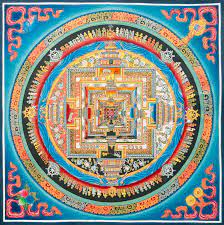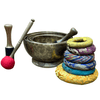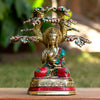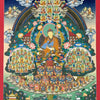Everything You Need to Know About Kalachakra Mandala

The Kalachakra mandala is certainly perhaps the most attractive Thangka Painting and appreciated for the emblematic components that make it and the visual portrayal of significant lessons of customary Tibetan Buddhism.
The Kalachakra Tantra is viewed as the most developed act of Vajrayana custom. This mind boggling arrangement of lessons was begun in India and consolidated into Tibetan Buddhist tradition.The Dalai Lama himself takes care of a progression of customs called "Kalachakra strengthening commencement" and the making of the Kalachakra mandala is utilized as a visual course book for Buddhist professionals.
Kalachakra Mandala Meaning
Kalachakra is a Sanskrit word made up of two terms; Kala meaning “Time” and chakra meaning “Cycle”, literally translated into English as “Cycle of Time”. But what does that actually mean?
It means: Everything in nature happens in Cycle of Time.
- Outer Kalachakra: the external environment, the universe and its cycles of arising and disintegrating.
- Inner Kalachakra: the sentient beings living in the universe, and the cycles of death and birth and internal flows of breath and energy;
- Alternative Kalachakra: The practice of purification undertaken by an individual so that ordinary death, birth, and manifestation on both an individual and universal level, which are usually uncontrollably subject to the passage of time, become purified into the fully Enlightened state of complete Buddhahood.
Kalachakra Manadala Significance

Related: Buy Mala Beads Online
The Kalacakra commencement depends on the ideas of time (kala) and cycles (chakra) and, prior to moving toward these customs, the supporter ought to have procured information on the three head parts of the Mahayana convention: Samsara, Bodhichitta and emptiness.In this article we won't analyze inside and out the philosophical parts of the Tantric inception yet we will zero in on clarifying the meaning of the images portrayed in the mandala.
Why
Kalachakra Mandala Art
As a matter of first importance it is imperative to realize how to show the Kalachakra mandala effectively. Notice the four unique shades of the primary internal components (red, yellow/orange, white and dark). The mandala should be situated with the dark side looking down.
The external ring is called intelligence circle or defensive ring. It is brightened with brilliant blazes and the mix of these tones make a rainbow that represent the five parts of the early stage intelligence and the five Dhyani Buddhas. After the space ring there are four internal rings addressing the four primary components: air, fire, water, and earth.The focal piece of the mandala had 3 unmistakable inward layers called body, discourse and psyche mandalas.
Design of Kalachakra Mandala Painting
The mathematical design is the projection of a grand royal residence with four doors and five stories. Inside the Body Mandala are addressed with syllables and images a sum of 536 divinities. Twelve creatures are portrayed inside the fundamental doors and securing the external dividers, addressing the months of the year.
The Body Mandala encompasses the Speech Mandala that has a similar math and within which are addressed a day and a half goddesses and 80 Yoginis.The most internal part is known as the brain Mandala that involve the last three stories of the royal residence and homes 80 divinities.
The lotus bloom at the middle is the image of the Buddha mind.
There are a few plan of thangka works of art of the Kalachakra mandala. In the most mind boggling craftsmanships two divinities are portrayed in the focal point of the mandala rather than the lotus blossom.
These significant gods are Kalachakra and Vishvamata portrayed in Yab-Yum: the heavenly Tantric association that represent the cyclic idea of time. This is the reason the Kalachakra Mandala is additionally called the "time wheel".
The Kalachakra Mandala is likewise addressed with quite possibly the most significant and notable image of the Tibetan Tantric practice: the Sanskrit seed syllables of the Kalachakra framework known as "the strong ten stacked syllables". Every syllable that make the mantra has an alternate tone and they are addressed all interconnected on top of a lotus blossom and encompassed by a ring of fire.
To ruminate over the mandala and discuss the Kalachakra mantra bring true serenity and advantages for every single aware being.
The incredible Kalachakra mantra is spelled: Om Ham Ksha Ma La Va Ra Ya Sva Ha.
Related: Wheel of Life Thangka






Kalchakra of my every positive energy which could not bloom in perfect time which disturbed by some elements what’s reason is that like i particles Hindu pancha bhotaahtaram too please guide me
This is so beautiful. I admire it so much. I do think that I would need to be shown and taught how to observe and absorb its meaning. I can’t see myself being able to understand it
That was an excellent post! I had no clue Mandalas and meditations were so popular. I’ve been researching and reading a lot about mandalas lately. I’m interested if any of you have any other resources to provide. It appears that finding the most up-to-date information on the website is challenging. I stumbled noticed a handful of relevant websites.https://www.pranalink.com/blog/post/meditation-and-mandala/?utm source=referrer&utm medium=organic is one of the websites. The majority of the website does not update regularly enough to assist me in learning more quickly. Is there anyone willing to assist?